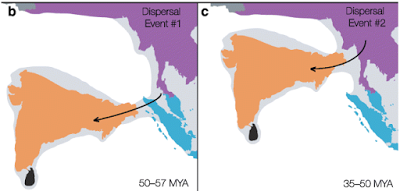At http://archaeologynewsnetwork.blogspot.co.uk/2016/03/land-bridges-linkin… … where we have an exercise based on an assumption. This is that India was once an island that was formerly attached to Antarctica and Australia and like the latter it travelled over millions of years across what is now the Indian Ocean to bump into Asia. It was an almighty bump as it involved that part of Asia folding over and over to create the Himalayan Mountains. Hence, the movement of India basically revolves around the current paradigm concerning how mountains came to be – and as that usually involves geological collisions there is no other possible alternate explanation. India must have been an island – but was it?
In this latest piece of computer simulation an attempt is made to understand how animals in India are said to resemble those in SE Asia and how animals on the island of India might have spread into Asia at large. One can that crabs have an affinity with India as it has a coast around three sides but dragon lizards with relatives in SE Asia are thought to have migrated into India at an undetermined point in the past. Of course, there is more to it than crabs and lizards but the drift of the article is to explain how certain animals came to be in India – indigenous to the island or migrants from outside. To get around this controversy, and the fairly late date for the bump the clever people on their computers postulate a series of two or three land bridges – which came and went as they have lots and lots of time to play around with, millions of years in fact. It's a bit like board games – moving animals around like houses and hotels on a monopoly board game. These bridges, it is theorised, occurred during the Eocene (prior to the actual bump). Stangely, in the image below, the Andaman Islands are ignored – and the ridge (mostly below sea level at the moment) that joined India to Indonesia. IN fact, one of the land bridges is depicted on top of the this ridge. Is it feasible?
 … One can do anything with a computer, moving sections of the continental crust around the globe – and using the board game as an example, like moving chess pieces or draughts, or leaping across large areas of the board as in snakes and ladders. It is necessary to keep the India bump into Asia hypothesis on the boil as geologists would then have to rethink mountain building. It is quite clear that if India had never been an island and was never detached from Asia the fact that animals exist that are similar in nearby regions is no problem. Even if India had been an island, a smaller version of itself with the Punjab under water, there would have been no problem as submergence would not have been permanent.
… One can do anything with a computer, moving sections of the continental crust around the globe – and using the board game as an example, like moving chess pieces or draughts, or leaping across large areas of the board as in snakes and ladders. It is necessary to keep the India bump into Asia hypothesis on the boil as geologists would then have to rethink mountain building. It is quite clear that if India had never been an island and was never detached from Asia the fact that animals exist that are similar in nearby regions is no problem. Even if India had been an island, a smaller version of itself with the Punjab under water, there would have been no problem as submergence would not have been permanent.
